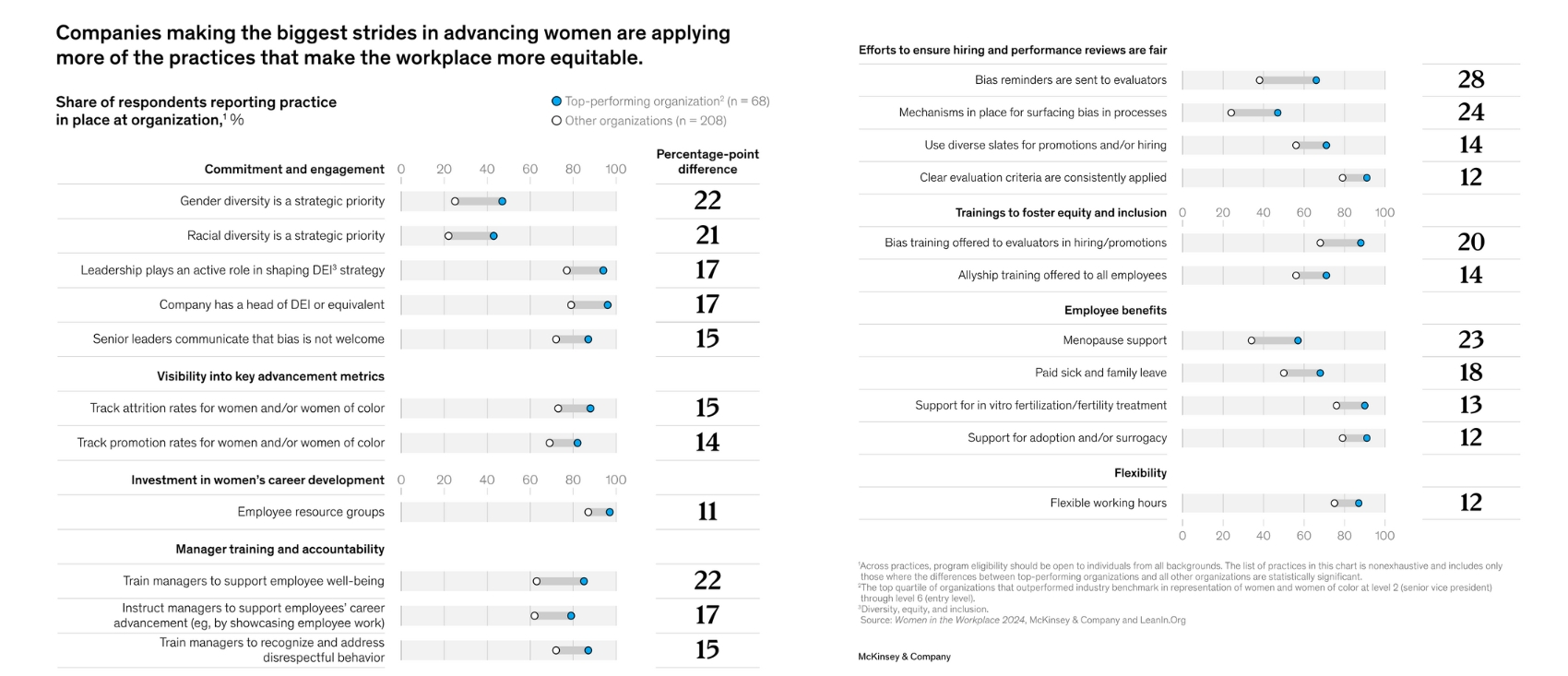The Women in the Workplace report by McKinsey & Company marks its 10-year anniversary with the publication of its 2024 report. This report, like its predecessors, offers invaluable insights into the progress made and the work that remains to be done.
The good news is that women’s representation in corporate leadership has shown encouraging growth over the past decade, with the number of women in C-suite positions nearly doubling from 17% to 28%. Yet despite this notable progress, there remains an ongoing need to continue efforts for women to gain parity.

This year’s report again highlights the “broken rung” at the entry level to management; seeing only 87 women for every 100 men promoted at this first stage, the ripple effect of this difference impacts women’s representation at all the subsequent stages of leadership. Intersectionality brings an additional layer of complexity, as women of colour face further barriers and often feel more heavily scrutinised and less supported.
“Yet progress is surprisingly fragile, especially for women of color, who continue to be underrepresented at every level and who view gender and race as obstacles to their advancement.”
What is very clear is that fostering inclusivity plays an important role. Organisations that make greater efforts to prioritise inclusivity are seeing marked tangible benefits. Women in these environments report higher job satisfaction, increased likelihood of recommending their company, and reduced burnout.

Exhibit 7, Women in the Workplace 2024: The 10th anniversary Report
Cultivating a culture of belonging and respect is essential for retaining and advancing diverse talent. Investing in leadership development programmes tailored to women’s experiences can accelerate progress. As the report outlines;
“At the current pace of progress, it would take 22 years for White women to reach parity – and it would take more than twice as long for women of color (Exhibit 4). Put another way, it would take 48 years for the representation of White women and women of color in senior leadership to reflect their share of the US population; this is true parity for all women. To achieve this, companies will need to maintain their current rate of progress, which means addressing weak spots in their pipelines: by finally fixing the broken rung, investing more resources in developing women leaders, and holding themselves accountable for more substantive progress in senior-leadership roles.”
The report stresses that the progress that has been made is fragile. This is seen several times, eg.
Companies are reporting declines in career development, mentorship, and sponsorship programmes geared toward women (Exhibit 5), as well as recruiting and internship programmes focused on women.
In the final analysis, the 10-year anniversary report celebrates the remarkable progress made toward increasing the representation of women in leadership roles. However, it also warns of the fragility of this progress, as the momentum of gender equality and female representation in senior positions shows signs of stalling – or worse, slipping into reverse. Evidence indicates that companies have begun scaling back programs specifically designed to empower women and boost their leadership potential, with a notable drop in the proportion of companies that prioritise gender diversity, inclusivity, and closing the gender gap within their organisations.
To foster real transformation and maximise women’s leadership potential, the report highlights the need for organisations to implement and uphold more robust debiasing practices in recruitment and advancement processes. This includes developing clear evaluation criteria for hiring and performance reviews, providing bias training for hiring evaluators, and ensuring diverse slates of candidates for leadership positions. Yet, despite the critical importance of these practices, only one in four companies surveyed have adopted all five core debiasing measures to support women’s advancement in executive leadership.
 Companies that commit to gender equality in the workplace and actively work to increase the number of women-led teams are more likely to outperform their competitors. Fostering an open environment, encouraging transformational growth, and providing mentors and coaches to guide emerging female leaders are all strategies that can accelerate gender parity.
Companies that commit to gender equality in the workplace and actively work to increase the number of women-led teams are more likely to outperform their competitors. Fostering an open environment, encouraging transformational growth, and providing mentors and coaches to guide emerging female leaders are all strategies that can accelerate gender parity.
This milestone report calls upon leaders and learning and development (L&D) teams to think ambitiously, providing unique opportunities for women executives to hone their leadership skills, participate in leadership development programs, and access executive coaches who can guide them toward maximising their potential. As companies seek to increase the number of women in senior leadership roles, they must also recognise the need for consistent support and investment in leadership skills, 360 assessments, and targeted mentoring.
If women’s parity is to be reached in less than the 48 years predicted by the writers of this report, companies still have a lot of work to do. While companies and organisations are on the right path with initiatives like flexible working the report fears that our work culture is stuck. This 10 year anniversary report is a call to action to leaders and L&D to think bigger, be more ambitious and apply more grit to this next stage in the parity process.
For those interested in furthering gender diversity in their organisations, we invite you to get in touch and discover how we can support your initiatives to create lasting change.
If you’d like to read our take on the 2023 report follow this link.